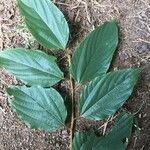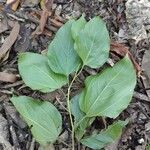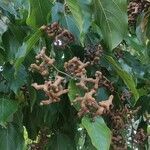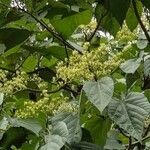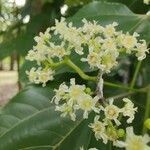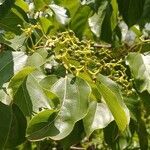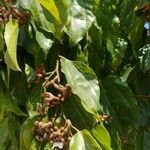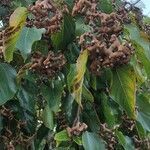Tree 5–10 m high, glabrous or sparsely rusty-hairy on young stems, leaf veins and flowers. Leaves: lamina broadly ovate, 80–150 mm long, 45–100 mm wide, base cordate, apex acuminate; petiole 20–60 mm long. Inflorescences terminal or axillary, hemispherical or pyramidal, with 20–50 flowers; bracts early caducous. Flowers greenish or cream. Pedicels 1.5–3 mm long. Hypanthium 1.8–2.2 mm diam. Sepals 1.8–2 mm long. Petals 2–2.2 mm long. Stamens 2–2.4 mm; anthers 0.5–0.6 mm long. Style 1.8–2 mm long, slightly lobed or branched in upper third. Capsule greenish or brown, 5–8 mm long. Seed 4–5 mm long, reddish-brown or black.
A tree which loses its leaves in winter. It can grow to 22 m tall. The tree has a single trunk and a round crown. The lower branches often drop off. The bark is deeply cracked. The leaves overlap. The leaves are shiny green. They are 15 cm long and limp. Masses of small cream flowers occur. The fruit stalk is swollen and it is edible. The seed pod is inedible and falls off. The stalk turns red and lets light through. This fruit stalk falls to the ground and is then ready to eat.
Trees, 5–10 m, branchlets glabrous. Leaves: petiole 2–4.5 cm; blade ovate, broadly oblong, or elliptic-ovate, 7–17 × 4–11 cm, herbaceous, base truncate or rarely cordate to subrounded, margins serrate, apex shortly acuminate or acuminate, both surfaces glabrous or abaxial pilose on major veins. Inflorescences usually terminal, rarely axillary, 50–80-flowered. Flowers 6–8 mm diam.; petals 2.4–2.6 mm. Capsules purplish to black at maturity, subglobose, 6.5–7.5 mm, glabrous.
A tree with curious swollen edible peduncles.
A native of China and Japan
